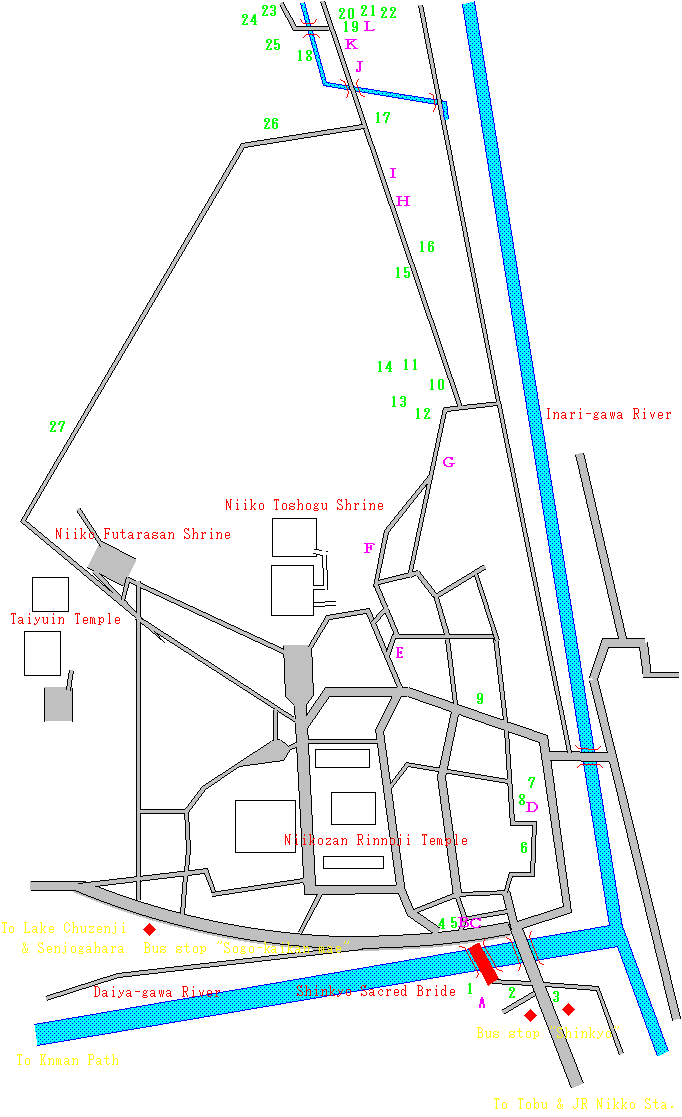1 Shinkyo Sacred Bridge
Shinkyo is beautiful red-lacquered bridge across the Daiya-gawa River.
It is 28meters long. According to the legend, when the priest Shodo, the
founder of Nikko first came to Nikko with his followers, a god helped them
to cross the rapid currents with his two snakes. They entwined themselves
into a bridge. |
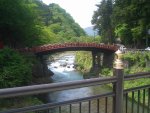 |
2 Statue of Itagaki Taisuke
Itagaki Taisuke (1817-1919) was a politician of the Meiji period. When
the pro-shogunate troops led by Otaori Keisuke occupied Nikko San'nai and
tried to destroy shrine and temples, he persuaded the troops and saved
from destruction. |
|
A Hoshi-no-miya (Iwasakunokami)
Priest Shodo had a dream when he was 7 years old. Myojo-tenshi (God of
the star) appeared in Priest Shodo's dream, and told him, "Civilize
mountainous Nikko after you studied Buddhism." Priest Shodo enshrined
the Myojo-tenshi after he opened the Nikko. |
 |
3 Statue of Tenkai
Archbishop Tenkai, a Buddhist priest of the Tendai sect, was gretly trusted
by the first Shogun Tokugawa Ieyasu and served three Shoguns (Ieyasu, Hidetada,
and Iemitsu) of the Tokugawa shogunate. |
 |
4 Jinja'o-do Sacred Hall
Jinja'o-do is a small red temple. Jinja'o is the name of god who helpled
priest Shodo cross the river. The current temple god has a power for' bridging
and match-making'. |
 |
5 Taro Sugi
'Sugi' is cedar or crypotmeria in Japanease. This sugi juts out into the
Route 120 near Shinkyo Bridge. Taro is a name usually given to something
that is greatest. It is approx. 550 years old, measures 5.75m in circumference
and 43m in heighit and one of the largest trees in Nikko. |
 |
B Monument of Contribution of Ceder Avenue
Masatnuna Matsudaira planted cedars, and contributed to Toshogu Shrine. |
 |
C Hongu Waterfall
This small waterfall next to the momument of cedar contribution. |
 |
6 Hongu Shrine
Hongu shrine is associated with Futarasan shrine. It was built in 790 by
the priest Shodo at the birthplace of Futarasan shrine. The first shrine
was destroyed by fire in 1984, but rebuilt in the next year. |
 |
D Shiunseki (Stone of Shiun) of Shihonryuji Temple
Four clouds appeared around the Shiunseki when Priest Shodo prayed. Those
four clouds are representatives of Seiryu (East) , Suzaku (South) , Byakko
(West) , and Genbu (North).
|
 |
7 Three-storied pagoda
This pagoda was orifinally built in 1241 at the Toshogu shrine precinct
by Buddhist priest Benkaku for the repose of the third Shogun of the Kamakura
shofunete, Minamoto no Sanetomo. The current pagoda was rebuilt in 1685
after the original pagoda was lost to a fire of 1684. 12 zodiac animals
are carved just under the roof of the first story. |
 |
8 Kannon-do Sacred Hall
An officer of local government, Toshihaya Tachibana enshrined Senju-Kannon
(1,000-armed Goddess of Mercy) in 807.
*7 & 8 are located at in the precinct of Shihon-ryu-ji Temple, the credle of
Nikko. |
 |
9 Kodama-do sacred hall
The red-lacquered temple is called Kodama-do. (lit. a shrine for a small
ball). According to the legend, When Kobo Daishi (774-835) was training
himself at Takino'o, he saw two white balls come out of apond. He believed
that two balls were incarnations of the holy spirits and built Kodama-do
for the somall ball.
|
 |
E Statue of Munehiro Koura
The statue is located in rhe Bajo Park.
Munehiro Koura was the mastre carpenter, who led designing and construction
in the period of Toshogu big reforming. |
 |
F Tomb of Kyobinsouzu
Kyoubinsouzu was the first follower of Priest Shodo. He became the second
successor of mountainous Nikko in 817. At the time of Toshogu Shrine reform,
it is said that an evil was caused whenever peopoe are going to move his
frave to the other places.
|
 |
G Trace of Yougenin House
It is a trace of temple that Eishouin built once. Eishouin was Yorifusa
Mito's mother-in-law. |
 |
10 Kaizan-do sacred Hall
After the death of Priest Shodo at his age of 83 in 817, the Kaizan-do
was built in Hotoke-iwa-dani, where the body of Priest Shodo was cremated. |
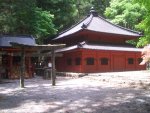 |
11 Grave of Prest Shodo ( Shodo Shonin)
There is a grave of Priest Shodo behind the Kaizan-do with three tombs
of his disciples. |
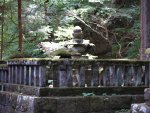 |
12 Kannon-do (San-no-miya)
This small building is popularly called San-no-miya (Shrine of Safe and
Easy Delivery of a child). It is also called Kyosha-do. Kyosha(香車) is one
of the pieces used in Japanease chess and it can move forward in a straight
line. This why Kyosha came to be related with a safe and easy delivery
of a child. |
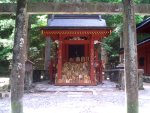 |
13 Onyo Seki
The Yin and Yang Stone. Two natural stones on the left of San-no-miya.
One (Yang) symbolizing a male and the other (Yin) a female. People pray
for the fertile land here. |
 |
14 Hotoke Iwa
Behind the -do, you can see a cliff. It is called Hotoke-iwa (lit. Buddha's
Stones). Before the collapse by the earthquake, it is said that people
could see the figures of Buddha on this cliff. Now you can find 6 stone
statuea of Buddha, called Ookubu-ten, just under this cliff. |
 |
15 Kitano shrine
This shrine was built in 1661. Sugawara Michizane who was a scholar of
the Heian period (794-1191) was enshrined as a God of Study. |
 |
16 Tegake Stone
This huge stone is called Tegake Ishi (stone). This stone is believed that
it has a power of improvement in schoolwork and handwriting. After your
visit to Kitano shrine, scrape a small piece off and place it on your family
altar or, just put your hand on this stone. |
 |
H Monument of God's Horse
It is the stone monument, which is srrounded by trees on the right side
of the approach. Ieyasu Tokugawa rode a house when he had the crucial battle
in Sekigahara, 1600. That house is enshrined there. |
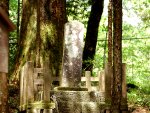 |
I Iimorisugi (Cedar of Iimori)
Iimori means to fill rice. The Iimorisugi looked like the filled rice,
but it is missing today. The Iimorisugi was estimated over 500 year old.
|
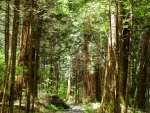 |
17 Monument of Prohibition of Urine and Feces
This monument is located on the crossroad to Gyosha-do Hall. Impure activites
were prohibited in the sacred pracinct. |
 |
J Bessho-ato (Trece of Branch of Takino'o Shrine
You will see a flat ground on the right after the stone stairs. The Bessho
was located there. It is told that Gohhanshiki (Compulsory rice eating)
was started ther..
|
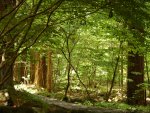 |
18 Shiraito water falls
This waterfall appears in the book of 'Kaikoku Zakki' written in 1486 and
is known as a famous falls for a long time. It is 10meters in height.
|
 |
K Yougouseki
The Yougouseki is the big stone, which is located on the deep right of
the approach. It is told that Saint Kobo worshipper Goddess on the stone. |
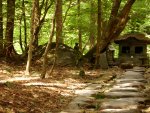 |
19 Undameshi-no-torii
Kaji Sadayshi, a retainer of 3rd Shogun Tokugawa Iemitsu built this Torii
(sacred gate) . Undameshi literally means 'try luck'. You may try your
luck by throwing pebbles three times through the hall of the forehead of
this Torii. If your pebble goes through the hall, you will know the degree
of your luck. |
 |
L Munen bridge
Crossing this Munen Bridge (lit. Chagrin bridge) once meant renouncing
. |
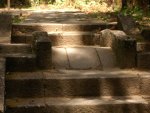 |
20 Takino'o Shrinel
This shrine was built by priest Kobo in 820. Current building (important
cultural property) was built in the early Edo period.
It is associated Futarasan shurine. |
 |
21 Enmusubi-no-sasa
This waterfall appears in the book of 'Kaikoku Zakki' written in 1486 and
is known as a famous falls for a long time. It is 10meters in height. |
|
22 Goshinboku
This waterfall appears in the book of 'Kaikoku Zakki' written in 1486 and
is known as a famous falls for a long time. It is 10meters in height. |
 |
23 Takino'o Inari Shrine
This waterfall appears in the book of 'Kaikoku Zakki' written in 1486 and
is known as a famous falls for a long time. It is 10meters in height. |
 |
24 Sake-no-izumi
This waterfall appears in the book of 'Kaikoku Zakki' written in 1486 and
is known as a famous falls for a long time. It is 10meters in height. |
 |
25 Kodane Stone
This waterfall appears in the book of 'Kaikoku Zakki' written in 1486 and
is known as a famous falls for a long time. It is 10meters in height. |
 |
26 Gyoja-do Sacred Hall
This waterfall appears in the book of 'Kaikoku Zakki' written in 1486 and
is known as a famous falls for a long time. It is 10meters in height. |
 |
27 Ku'en Jizo
This waterfall appears in the book of 'Kaikoku Zakki' written in 1486 and
is known as a famous falls for a long time. It is 10meters in height. |
 |
|
|
